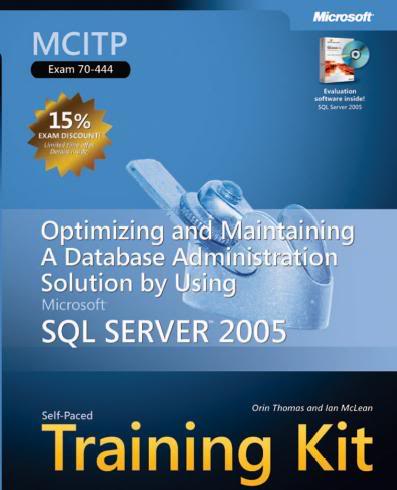Exam 70-642:
TS: Windows Server 2008 Network Infrastructure, Configuring
Published: March 06, 2008
Language(s): English, French, German, Italian, Japanese, Korean, Russian, Spanish, Portuguese (Brazil), Chinese (Simplified)
Audience(s): IT Professionals
Technology: Windows Server 2008
Type: Proctored Exam
About this ExamThe Microsoft Certified Technology Specialist (MCTS) on Windows Server 2008 credential is intended for IT professionals who work in the complex computing environment of medium-sized to large companies.
Audience Profile
The Microsoft Certified Technology Specialist (MCTS) on Windows Server 2008 credential is intended for IT professionals who work in the complex computing environment of medium-sized to large companies. The MCTS candidate should have at least one year of experience implementing and administering a network operating system in an environment that has the following characteristics:
* 250 to 5,000 or more users
* Three or more physical locations
* Three or more domain controllers
* Network services and resources, such as messaging, a database, file and print, a proxy server, a firewall, the Internet, an intranet, remote access, and client computer management
* Connectivity requirements, such as connecting branch offices and individual users in remote locations to the corporate network and connecting corporate networks to the Internet
Credit Toward Certification
When you pass Exam 70-642: TS: Windows Server 2008 Network Infrastructure, Configuring, you complete the requirements for the following certification(s):
* Microsoft Certified Technology Specialist (MCTS): Windows Server 2008 Network Infrastructure, Configuring
Exam 70-642: TS: Windows Server 2008 Network Infrastructure, Configuring: counts as credit toward the following certification(s):
* Microsoft Certified IT Professional (MCITP): Enterprise Administrator
* Microsoft Certified IT Professional (MCITP): Server Administrator
Note This preparation guide is subject to change at any time without prior notice and at the sole discretion of Microsoft. Microsoft exams might include adaptive testing technology and simulation items. Microsoft does not identify the format in which exams are presented. Please use this preparation guide to prepare for the exam, regardless of its format.
About this ExamThe Microsoft Certified Technology Specialist (MCTS) on Windows Server 2008 credential is intended for IT professionals who work in the complex computing environment of medium-sized to large companies.

Audience Profile
The Microsoft Certified Technology Specialist (MCTS) on Windows Server 2008 credential is intended for IT professionals who work in the complex computing environment of medium-sized to large companies. The MCTS candidate should have at least one year of experience implementing and administering a network operating system in an environment that has the following characteristics:
* 250 to 5,000 or more users
* Three or more physical locations
* Three or more domain controllers
* Network services and resources, such as messaging, a database, file and print, a proxy server, a firewall, the Internet, an intranet, remote access, and client computer management
* Connectivity requirements, such as connecting branch offices and individual users in remote locations to the corporate network and connecting corporate networks to the Internet
Credit Toward Certification
When you pass Exam 70-642: TS: Windows Server 2008 Network Infrastructure, Configuring, you complete the requirements for the following certification(s):
* Microsoft Certified Technology Specialist (MCTS): Windows Server 2008 Network Infrastructure, Configuring
Exam 70-642: TS: Windows Server 2008 Network Infrastructure, Configuring: counts as credit toward the following certification(s):
* Microsoft Certified IT Professional (MCITP Training ): Enterprise Administrator
* Microsoft Certified IT Professional (MCITP Certification): Server Administrator
Note This preparation guide is subject to change at any time without prior notice and at the sole discretion of Microsoft. Microsoft exams might include adaptive testing technology and simulation items. Microsoft does not identify the format in which exams are presented. Please use this preparation guide to prepare for the exam, regardless of its format.
Skills Being Measured
This exam measures your ability to accomplish the technical tasks listed below.The percentages indicate the relative weight of each major topic area on the exam.
Configuring IP Addressing and Services (24 percent)
* Configure IPv4 and IPv6 addressing. May include but is not limited to: configure IP options, subnetting, supernetting, alternative configuration
* Configure Dynamic Host Configuration Protocol (DHCP). May include but is not limited to: DHCP options, creating new options, PXE boot, default user profiles, DHCP relay agents, exclusions, authorize server in Active Directory, scopes, server core, Windows Server Hyper-V
* Configure routing. May include but is not limited to: static routing, persistent routing, Routing Internet Protocol (RIP), Open Shortest Path First (OSPF)
* Configure IPsec. May include but is not limited to: create IPsec policy, IPsec Authentication Header (AH), IPsec Encapsulating Security Payload (ESP)
Configuring Name Resolution (27 percent)
* Configure a Domain Name System (DNS) server. May include but is not limited to: conditional forwarding, external forwarders, root hints, cache-only, server core, WINS and DNS integration, Windows Server virtualization
* Configure DNS zones. May include but is not limited to: DNS Refresh no-refresh, intervals, DNS listserv address (NSLOOKUP), primary/secondary zones, Active Directory integration, Dynamic Domain Name System (DDNS), GlobalNames, SOA refresh
* Configure DNS records. May include but is not limited to: record types, host, pointer, MX, SRV, NS, dynamic updates, Time to Live (TTL)
* Configure DNS replication. May include but is not limited to: DNS secondary zones, DNS stub zones, DNS scavenging interval, replication scope
* Configure name resolution for client computers. May include but is not limited to: DNS and WINS integration, configuring HOSTS file, LMHOSTS, node type, Link-Local Multicast Name Resolution (LLMNR), broadcasting, resolver cache, DNS Server list, Suffix Search order, manage client settings by using group policy
Configuring Network Access (22 percent)
* Configure remote access. May include but is not limited to: dial-up, Remote Access Policy, Network Address Translation (NAT), Internet Connection Sharing (ICS), VPN, Routing and Remote Access Services (RRAS), inbound/outbound filters, configure Remote Authentication Dial-In User Service (RADIUS) server, configure RADIUS proxy, remote access protocols, Connection Manager
* Configure Network Access Protection (NAP). May include but is not limited to: network layer protection, DHCP enforcement, VPN enforcement, configure NAP health policies, IPsec enforcement, 802.1x enforcement, flexible host isolation
* Configure network authentication. May include but is not limited to: LAN authentication by using NTLMv2 and Kerberos, WLAN authentication by using 802.1x, RAS authentication by using MS-CHAP, MS-CHAP v2, and EAP
* Configure wireless access. May include but is not limited to: Set Service Identifier (SSID), Wired Equivalent Privacy (WEP), Wi-Fi Protected Access (WPA), Wi-Fi Protected Access 2 (WPA2), ad hoc versus infrastructure mode, group policy for wireless
* Configure firewall settings. May include but is not limited to: incoming and outgoing traffic filtering, Active Directory account integration, identify ports and protocols, Microsoft Windows Firewall versus Windows Firewall with Advanced Security, configure firewall by using group policy, isolation policy
Configuring File and Print Services (13 percent)
* Configure a file server. May include but is not limited to: file share publishing, Offline Files, share permissions, NTFS permissions, encrypting file system (EFS)
* Configure Distributed File System (DFS). May include but is not limited to: DFS namespace, DFS configuration and application, creating and configuring targets, DFS replication
* Configure shadow copy services. May include but is not limited to: recover previous versions, set schedule, set storage locations
* Configure backup and restore. May include but is not limited to: backup types, backup schedules, managing remotely, restoring data
* Manage disk quotas. May include but is not limited to: quota by volume or quota by user, quota entries, quota templates
* Configure and monitor print services. May include but is not limited to: printer share, publish printers to Active Directory, printer permissions, deploy printer connections, install printer drivers, export and import print queues and printer settings, add counters to Reliability and Performance Monitor to monitor print servers, print pooling, print priority
Monitoring and Managing a Network Infrastructure (14 percent)
* Configure Windows Server Update Services (WSUS) server settings. May include but is not limited to: update type selection, client settings, Group Policy object (GPO), client targeting, software updates, test and approval, disconnected networks
* Capture performance data. May include but is not limited to: Data Collector Sets, Performance Monitor, Reliability Monitor, monitoring System Stability Index
* Monitor event logs. May include but is not limited to: custom views, application and services logs, subscriptions, DNS log
* Gather network data. May include but is not limited to: Simple Network Management Protocol (SNMP), Baseline Security Analyzer, Network Monitor
Preparation Tools and ResourcesTo help you prepare for this exam, Microsoft Learning recommends that you have hands-on experience with the product and that you use the following training resources. These training resources do not necessarily cover all of the topics listed in the “Skills Measured” tab.
Classroom Training
6421A: Configuring and Troubleshooting a Windows Server 2008 Network Infrastructure (5 Days)
Microsoft E-Learning
6420AE: Fundamentals of a Windows Server 2008 Network Infrastructure and Application Platform (20 Hours)
6421AE: Configuring and Troubleshooting a Windows Server 2008 Network Infrastructure (20 Hours)
Microsoft Press Books
MCITP Self-Paced Training Kit (Exams 70-640, 70-642, 70-643, 70-647): Windows Server 2008 Enterprise Administrator Core Requirements
MCTS Self-Paced Training Kit (Exam 70-642): Configuring Windows Server 2008 Network Infrastructure
MCITP Self-Paced Training Kit (Exams 70-640, 70-642, 70-646): Server Administrator Core Requirements
Practice Tests
* https:://www.certkingdom.com
Microsoft Online Resources
* Windows Server 2008 – Learning Portal: Find special offers and information on training and certification.
* Product information: Visit the Windows Server 2008 Web site for detailed technology information.
* Microsoft Learning Community: Join newsgroups and visit community forums to connect with your peers for suggestions on training resources and advice on your certification path and studies.
* TechNet: Designed for IT professionals, this site includes how-to instructions, best practices, downloads, technical resources, newsgroups, and chats.
* MSDN: Designed for developers, the Microsoft Developer Network (MSDN) features code samples, technical articles, downloads, newsgroups, and chats.





